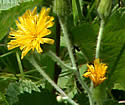Hieracium scabrum (Sticky Hawkweed)
| Also known as: | Rough Hawkweed |
|---|---|
| Genus: | Hieracium |
| Family: | Asteraceae (Aster) |
| Life cycle: | perennial |
| Origin: | native |
| Habitat: | part shade, sun; dry sandy soil; open woods and woodland edges |
| Bloom season: | July - September |
| Plant height: | 1 to 3 feet |
| Wetland Indicator Status: | none |
| MN county distribution (click map to enlarge): |  |
| National distribution (click map to enlarge): |  |
Pick an image for a larger view. See the glossary for icon descriptions.
Detailed Information
Flower: 

![[photo of flowers]](/udata/r9ndp23q/pd2/hieracium-scabrum-1-t.jpg) Open cluster to 12 inches tall of 10 to 25 yellow dandelion-like flowers on long stalks. Flowers are ½ to 1 inch wide; floral bracts and flower stalks are green and covered to varying degrees in short glandular hairs. A small leafy bract is often on the stem where flower clusters branch.
Open cluster to 12 inches tall of 10 to 25 yellow dandelion-like flowers on long stalks. Flowers are ½ to 1 inch wide; floral bracts and flower stalks are green and covered to varying degrees in short glandular hairs. A small leafy bract is often on the stem where flower clusters branch.
Leaves and stems: 

![[photo of leaves]](/udata/r9ndp23q/pd2/hieracium-scabrum-4-t.jpg) Leaves are 2 to 8 inches long, ½ to 2 inches wide, broadly oval-elliptic tapered to a dull point, smooth or with a few tiny teeth around the edges, hairy on both surfaces. Leaves near the base are largest, short stalked, and more densely packed on the stem, becoming smaller, stalkless, and more widely spaced as they ascend the stem. The main stem is covered with spreading hairs that are glandular only near the flower clusters. It has no stolons so doesn't produce mats.
Leaves are 2 to 8 inches long, ½ to 2 inches wide, broadly oval-elliptic tapered to a dull point, smooth or with a few tiny teeth around the edges, hairy on both surfaces. Leaves near the base are largest, short stalked, and more densely packed on the stem, becoming smaller, stalkless, and more widely spaced as they ascend the stem. The main stem is covered with spreading hairs that are glandular only near the flower clusters. It has no stolons so doesn't produce mats.
Notes:
Fairly common, Sticky Hawkweed doesn't stand out amongst the many competing, similar species. Neither a practitioner of open meadow or deep woods, scattered populations along dry sandy tree lines is a helpful clue to its identity. The leaf shape and arrangement on the stem also distinguishes it from the more aggressive non-native hawkweeds.
Native Plant Nurseries, Restoration and Landscaping Services ↓
More photos
Photos courtesy Peter M. Dziuk taken in St. Louis County.
Comments
Have you seen this plant in Minnesota, or have any other comments about it?
on: 2015-11-02 14:49:24
I saw this species in bloom where the wooded and outcrop parts of a ridge met, at Rushford Sand Barrens SNA on October 26, 2015.
on: 2021-06-18 13:23:39
You don't mention black glands on the involucres and peduncles of H. scabrum. Have you found this an unreliable character?
on: 2021-06-18 13:38:46
Charles, the glandular hairs are mentioned, but they may or may not be black. Black hairs or glands is a characteristic of multiple Hieracium species.







 Sticky Hawkweed plant
Sticky Hawkweed plant